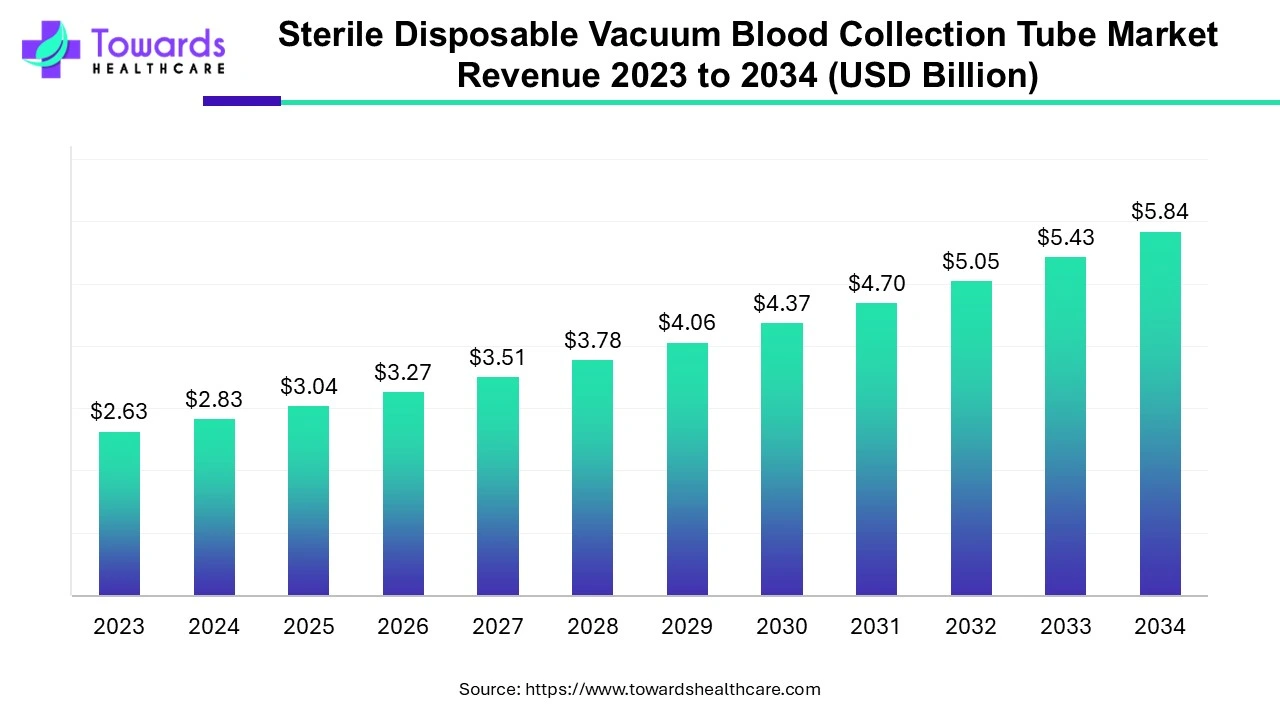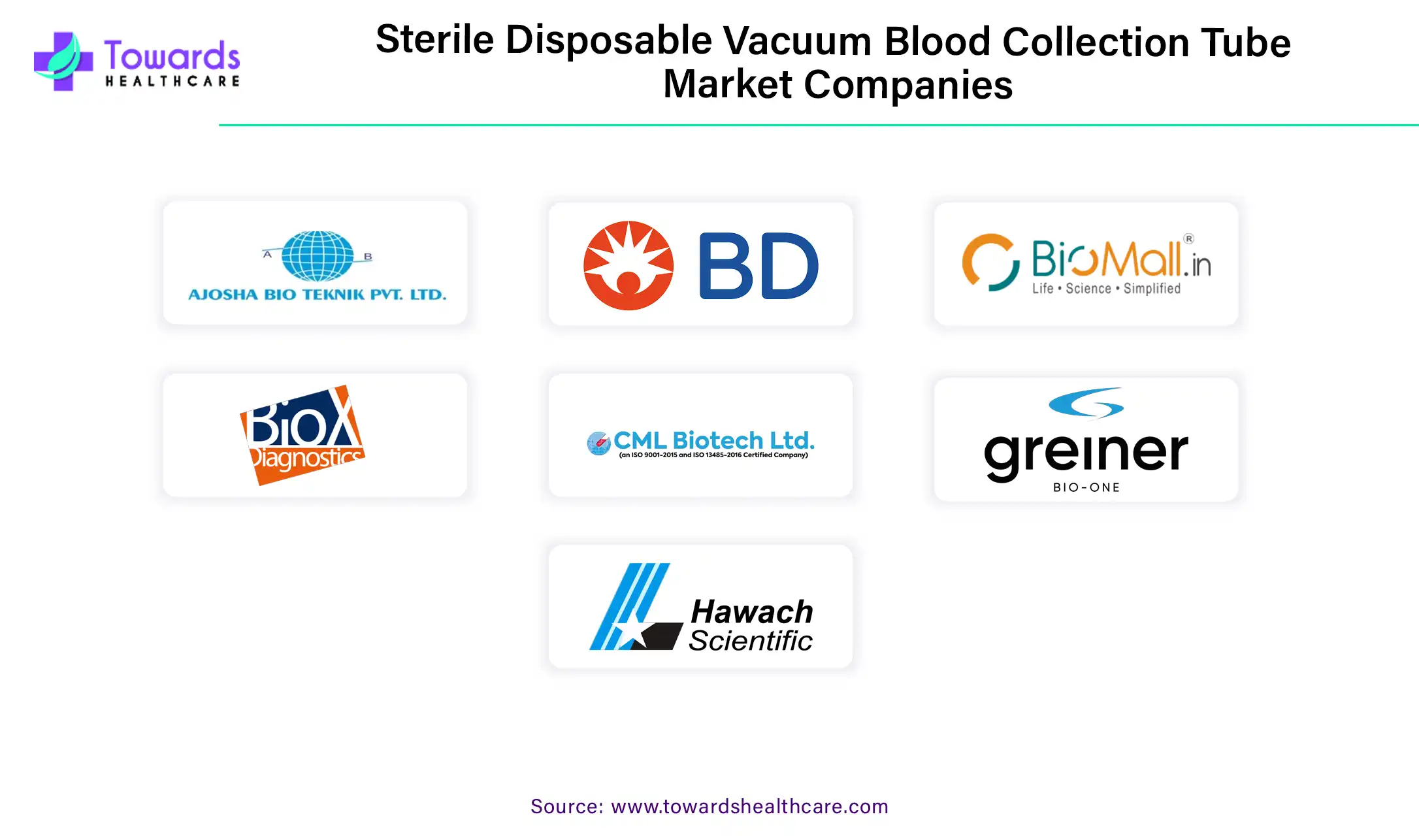February 2025

The sterile disposable vacuum blood collection tube market was estimated at US$ 2.63 billion in 2023 and is projected to grow to US$ 5.84 billion by 2034, rising at a compound annual growth rate (CAGR) of 7.53% from 2024 to 2034. The increasing number of biochemical and immunological tests and the rising prevalence of chronic disorders drive the market.

Vacuum blood collection tubes are sterile, sealed tubes used to collect blood samples from patients. They are made of either glass or plastic and have a color-coded rubber stopper at one end and a needle at the other. These tubes are designed for single use only and are disposed of after use to maintain sterility and prevent contamination. Depending on the type of test to be performed on the blood sample, these tubes also contain additives such as anticoagulants, clot activators, or preservatives. The color of the stopper indicates the additives in the tube.
The increasing number of laboratory tests such as biochemical, immunological, diabetes, and tuberculosis tests potentiates the use of blood collection tubes. The growing demand for sterile and disposable tubes to prevent cross-contamination among patients and increasing investments in healthcare infrastructure boost the market. Favorable government policies and increasing awareness to prevent chronic disorders increase the demand for frequent laboratory tests.
Artificial intelligence (AI) has found numerous applications in every aspect of the healthcare sector. However, the use of AI in sterile disposable vacuum blood collection tubes is still in its infancy. It can play a crucial role in introducing automation in the manufacturing process. This leads to improved efficiency, reproducibility, and reduced manual errors. Integrating AI in blood collection tubes can detect errors during diagnosis and blood collection process. It can digitally indicate the amount of blood collected per patient. Thus, introducing AI can present a compelling growth opportunity for market players.
Vacuum blood collection tubes are predominantly used in laboratory and clinical settings to collect blood samples safely and effectively. The rising prevalence of chronic disorders, growing demand for preventive care, and the need for frequent checking necessitate diagnostic testing. The increasing number of laboratories and clinical pathology labs globally also govern market growth. The advancements in testing methodologies and the development of novel diagnostic instruments facilitate state-of-the-art diagnostic tests. The COVID-19 pandemic showed a positive influence on the market due to rising lab testing. It is estimated that more than 14 billion clinical lab tests are performed in the US annually.
Advanced technologies are revolutionizing the way sterile disposable vacuum blood collection tubes are manufactured. Introducing automation in production lines enhances efficiency, reproducibility, consistency, and sterility. Automation plays a key role in manufacturing from tube loading & detection to packaging. Several organizations have implemented advanced technologies to manufacture vacuum blood collection tubes to produce high-quality products, fulfill demand by producing huge quantities in less time, and strengthen their position in the competitive market.
Additionally, RFID tags, barcodes, and IoT-enabled blood collection tubes are the future of blood collection. Instead of manual labels on the tubes, barcodes or RFID tags enable easy identification and detection of patient data from the blood samples. These tags can also aid in better tracking and monitoring of samples and avoid mixing of test results which is crucial in complex lab environments.
The major challenge of the market is the supply chain disruptions due to high demand. Manufacturers face intermittent supply chain disruptions caused by transportation delays and raw material shortages. In January 2022, the US FDA expanded the medical device shortage list to include all blood collection tubes due to supply challenges led by an increase in demand during the pandemic and vendor issues. Another major challenge is the loss of blood samples. Vacuum blood collection tubes collect 4-5 ml of blood at a time. However, only a minute quantity of blood is required for laboratory tests, resulting in the loss of blood samples. Hence, consumers prefer non-vacuum blood collection tubes and small-volume tubes.
North America dominated the sterile disposable vacuum blood collection tube market in 2023. The rising prevalence of chronic disorders, the presence of key players, advanced healthcare infrastructure, and the increasing awareness of laboratory tests drive the market. According to the Centers for Disease Control and Prevention, approximately 14 billion clinical laboratory tests are performed annually in the US. 70% of the medical decisions depend on laboratory test results. Whereas in Canada, approximately 1.2 million laboratory tests are performed every day. The greater number of lab tests demands vacuum blood collection tubes. There are around 260,000 CLIA-certified laboratories across the US. There are 4,215 medical and diagnostic laboratories in Canada as of 2023.
Asia-Pacific is expected to grow at the fastest rate in the sterile disposable vacuum blood collection tube market during the forecast period. The increasing population, rising prevalence of chronic disorders, increasing demographics & urbanization, and rapidly expanding healthcare infrastructure drive the market. There are over 100,000 clinical labs in India and around 2,100 clinical laboratories in China. The increasing number of diagnostic laboratories results in huge demands for vacuum blood collection tubes.
Countries like China and India have favorable manufacturing infrastructure to produce blood collection tubes. Additionally, the rising prevalence of chronic disorders such as cancer, diabetes, heart disease, HIV/AIDS, and many more require frequent blood tests. Asia has the highest cancer burden in the world with 23,429,909 prevalent cases in a span of 5-years. While there are around 300 million diabetes cases in Asia-Pacific, potentiating the demand for frequent blood tests.
By product, the serum separating tubes segment held a dominant presence in the sterile disposable vacuum blood collection tube market in 2023. Serum-separating tubes are used for lab tests that require blood serum. These tubes enable fast and reliable separation of serum from blood clots, reducing waiting times and improving the accuracy of lab tests. They are used to measure drug or hormone levels from blood serum.
The EDTA tubes segment is predicted to witness significant growth in the market over the forecast period. EDTA is present in vacuum blood collection tubes as an anticoagulant to prevent blood clotting, preserving blood until testing. EDTA tubes are used for hematology purposes, where whole blood is required for examination. These tubes enable accurate test results making them a standard choice in medical diagnostics.
By material, the plastic segment accounted for a considerable share of the sterile disposable vacuum blood collection tube market in 2023. Plastics are widely preferred in blood collection tubes as they can be easily disposed of. They are cheap, easy to handle, and non-fragile. The two most common types of plastics used are polypropylene and polyethylene terephthalate.
By end-user, the hospital segment held the largest share of the sterile disposable vacuum blood collection tube market in 2023. The segmental growth is attributed to the greater number of tests in hospitals, the presence of skilled personnel, and favorable facilities.
The diagnostic centers segment is projected to grow significantly in the market in the coming years. Diagnostic centers provide both specialized and multidisciplinary tests due to diverse patient needs. Rapid urbanization and increasing investments drive the segment growth.
In June 2023, Husky Technologies announced the installation of the first integrated injection molding system for blood collection tubes in India at the facilities of CML Biotech Ltd. Thomas Bontempi, Head of Medical Business Development at Husky Technologies, commented that their goal was to enable CML Biotech’s business growth and the injection molding system provides end-to-end visibility with proactive, predictive, and transparent monitoring, assuring consistent performance and optimal production.

By Product
By Material
By End-User
By Region
February 2025
November 2024
November 2024
December 2024